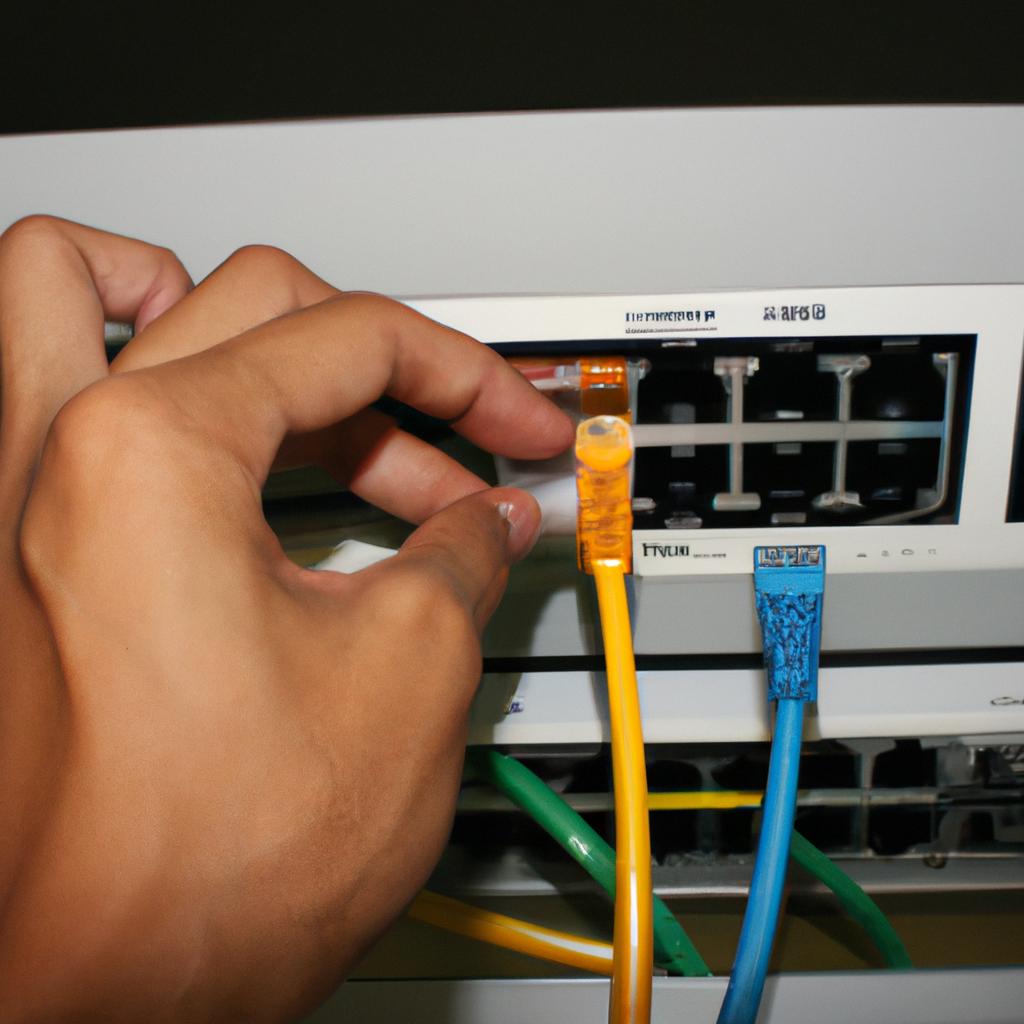Emulators have become an essential tool in the field of computer systems as they allow software to run on different hardware platforms. They provide a means for developers and researchers to test, debug, and analyze programs without the need for physical devices. However, ensuring optimal performance when using emulators can be challenging due to the inherent differences between the host and target systems. This article aims to explore the various system requirements and performance considerations that need to be taken into account while utilizing computer systems emulators.
Consider a scenario where a video game developer wants to create a version of their game for multiple gaming consoles. Instead of investing in several physical consoles, they decide to use an emulator that allows them to test their game on each platform from their development machine. While this approach offers convenience, it raises questions about whether the emulator is able to accurately replicate the behavior of each console’s hardware components. Additionally, there may be concerns regarding performance issues such as latency or graphical fidelity that could impact user experience. Therefore, understanding the system requirements and potential performance limitations of computer systems emulators becomes crucial in such cases.
In conclusion, with the increasing reliance on computer systems emulators in various domains including software development and research, it is important to consider their system requirements and address potential performance challenges to ensure optimal usage. By carefully selecting a suitable emulator that accurately replicates the target hardware, developers can minimize any discrepancies or compatibility issues that may arise. It is also important to consider the host system’s specifications, such as CPU power, memory capacity, and graphics capabilities, to ensure smooth emulation performance.
Furthermore, developers should be aware of potential performance limitations when using emulators. Emulation introduces an additional layer of processing overhead, which can impact the speed and responsiveness of software running on the emulator. Factors such as latency, graphical fidelity, and audio synchronization may need to be taken into account to provide a seamless user experience.
To address these challenges, it is recommended to regularly update both the emulator software and host system drivers to benefit from bug fixes and performance optimizations. Additionally, optimizing code for efficient execution on emulated systems can help improve overall performance.
In summary, understanding the system requirements and potential performance considerations when using computer systems emulators is crucial in order to achieve accurate replication of hardware behavior and maintain optimal user experience. By taking these factors into account and implementing necessary optimizations, developers can effectively utilize emulators in their workflows.
Understanding System Requirements
Emulating computer systems has become an increasingly common practice in various industries, such as software development and testing. However, to ensure smooth emulation and optimal performance, it is crucial to understand the system requirements involved. By comprehending these requirements, users can make informed decisions regarding hardware configurations and allocate resources effectively.
To illustrate the importance of understanding system requirements, let us consider a hypothetical case study involving a gaming company developing an emulator for their classic console. The company aims to provide gamers with an authentic experience that replicates the original hardware environment. Without a thorough understanding of system requirements, they may underestimate the necessary processing power or memory capacity required for seamless emulation. This oversight could result in subpar performance, leading to frustrated customers and negative reviews.
When considering system requirements for emulators, there are several key factors to take into account:
- Processing Power: Emulation involves simulating the behavior of another system on top of existing hardware. This process demands significant computational resources and requires processors capable of executing complex instructions efficiently.
- Memory Capacity: Emulated systems often require large amounts of memory for storing game ROMs, save states, and other data during runtime. Sufficient RAM ensures smooth operation without excessive swapping between main memory and storage devices.
- Graphics Capability: Many emulated systems rely heavily on graphic rendering capabilities. Adequate graphics cards enable accurate reproduction of visuals while minimizing frame drops or screen tearing.
- Input/Output Interfaces: Emulators must support various input/output interfaces specific to each emulated system. These interfaces include controllers, peripherals, network connections, audio output devices, etc.
Considering these factors allows developers and users alike to evaluate whether their current hardware configuration meets the minimum requirements for running emulators effectively. It also helps them understand where potential bottlenecks might occur and how they can be addressed through upgrades or adjustments.
In the subsequent section about “Factors Affecting Emulator Performance,” we will delve deeper into the specific aspects that can impact an emulator’s performance. By understanding these factors, users can optimize their systems and overcome potential hurdles for a seamless emulation experience.
Factors Affecting Emulator Performance
Transitioning from our previous discussion on understanding system requirements, it is important to delve into the factors that can significantly impact emulator performance. To illustrate this concept, let us consider a hypothetical scenario where an individual aims to use a computer systems emulator to run resource-intensive video editing software.
Several key elements contribute to the overall performance of an emulator and should be carefully considered when selecting or configuring one for specific tasks:
-
Processor (CPU) Capability: A powerful CPU enables efficient emulation by swiftly executing instructions required by the emulated system. Multiple cores and high clock speeds allow for better multitasking and faster execution of complex operations within the emulator.
-
Memory (RAM): Sufficient memory capacity is crucial in ensuring smooth operation of emulators, especially when running demanding applications or multiple virtual machines simultaneously. Inadequate RAM may lead to frequent swapping between physical memory and disk storage, causing significant slowdowns.
-
Graphics Processing Unit (GPU): Although not as critical as CPU and memory capabilities, a capable GPU can enhance graphics rendering within an emulator, resulting in improved visual fidelity and smoother user experiences.
-
Storage Speed: The speed at which data is read from and written to storage devices affects loading times within emulators. Solid-state drives (SSDs) typically offer faster access times compared to traditional hard disk drives (HDDs), leading to reduced latency during application launches and file transfers.
To further emphasize the significance of these factors, consider Table 1 below, showcasing their influence on different aspects of emulator performance:
| Performance Aspect | Influence |
|---|---|
| Execution Speed | Directly impacted by CPU capability |
| Application Loading | Dependent on storage speed |
| Resource Utilization | Affected by both CPU & memory capacities |
| Graphics Rendering | Enhanced with a capable GPU |
With a clear understanding of the factors that can influence emulator performance, we can now proceed to explore how CPU and memory considerations play a pivotal role in determining overall system requirements for successful emulation.
CPU and Memory Considerations
Emulator performance is greatly influenced by the capacity and speed of the computer’s memory and storage components. In order to ensure optimal performance, it is essential to carefully consider these factors when setting up an emulator system.
One example that illustrates the importance of memory and storage considerations is the case of a gaming emulator. Imagine a scenario where a user wants to run a high-end console game on their computer using an emulator. The game requires significant amounts of memory for smooth gameplay and quick loading times. If the computer’s memory capacity falls short or its access speed is slow, it can lead to lagging gameplay, frequent stutters, and longer loading screens, ultimately resulting in a poor gaming experience.
To further emphasize the significance of memory and storage considerations, let us explore four key points that highlight their impact on emulator performance:
- Memory Capacity: Emulators often require large amounts of memory to accurately emulate different hardware architectures. Insufficient memory can cause slowdowns and crashes.
- Memory Speed: Faster memory modules allow for quicker data retrieval, ensuring smoother emulation performance.
- Storage Type: Solid-state drives (SSDs) offer faster read/write speeds compared to traditional hard disk drives (HDDs). Using SSDs can significantly reduce load times during emulation.
- Storage Capacity: Emulating multiple systems simultaneously or running games with large file sizes necessitates ample storage space to accommodate all necessary files.
The following table provides a comparison between HDDs and SSDs in terms of their respective characteristics:
| Characteristic | Hard Disk Drives (HDDs) | Solid-State Drives (SSDs) |
|---|---|---|
| Read/Write Speed | Slower | Faster |
| Reliability | Susceptible to damage | More durable |
| Noise Level | Audible spinning noise | No moving parts |
| Power Consumption | Higher | Lower |
Considering the impact of memory and storage on emulator performance, it becomes evident that investing in sufficient memory capacity and faster storage options can greatly enhance the overall experience.
Transitioning into the subsequent section about “Graphics and Display Requirements,” it is crucial to understand how graphical capabilities play a vital role in determining emulator performance. By optimizing system resources for graphics processing, users can ensure smooth rendering and an immersive visual experience.
Graphics and Display Requirements
Section H2: Graphics and Display Requirements
Transitioning from the previous section on CPU and Memory considerations, it is essential to address another crucial aspect of system requirements for computer systems emulators – graphics and display requirements. The performance and visual quality of an emulator heavily depend on these factors, as they directly impact the user experience.
Consider a scenario where a user wants to run a gaming console emulator on their computer system. Without adequate graphics capabilities, the user may encounter issues such as lag, screen tearing, or even complete incompatibility with certain games. Therefore, understanding the graphics and display requirements becomes paramount when selecting or configuring a computer system to emulate various platforms effectively.
To optimize the graphical output of an emulator, several key considerations should be taken into account:
- GPU (Graphics Processing Unit): A powerful GPU ensures smooth rendering of complex visuals by offloading processing tasks from the CPU.
- Resolution Support: Emulators should support different resolutions commonly used by target platforms to ensure accurate replication of their native displays.
- Refresh Rate: Higher refresh rates contribute to smoother animations and reduced motion blur during gameplay.
- Compatibility with 3D Acceleration: Some emulation software requires specific 3D acceleration features supported by GPUs for optimal performance.
In addition to these considerations, it can be beneficial to provide examples through case studies or hypothetical scenarios that illustrate how well-configured graphics and display requirements enhance the overall emulation experience. This helps users understand the importance of investing in suitable hardware components or adjusting settings within existing systems.
| Graphics & Display Requirements | Minimum Specification | Recommended Specification |
|---|---|---|
| GPU | DirectX 11 compatible | Dedicated high-performance GPU |
| Resolution Support | Up to 1080p | Up to 4K resolution |
| Refresh Rate | 60Hz | At least 120Hz |
| Compatibility with 3D Acceleration | Basic support | Advanced support |
This table provides a concise summary of minimum and recommended specifications for graphics and display requirements in computer systems emulators. Meeting the recommended specifications ensures an optimal experience while using the emulator, especially when running high-demanding games or applications.
As we move forward to the subsequent section on “Storage and Disk Space,” it is essential to consider how these aspects interact with graphics capabilities, as they collectively contribute to creating a well-rounded emulation environment. Understanding their interconnected nature enables users to make informed choices regarding system configurations that strike a balance between performance and overall user satisfaction.
Storage and Disk Space
Section H2: Storage and Disk Space
Having discussed the graphics and display requirements in the previous section, it is now imperative to delve into another crucial aspect of system requirements for computer systems emulators – storage and disk space. To illustrate the significance of this consideration, let us consider a hypothetical case study involving an emulator designed to run a modern video game console on personal computers.
Example Scenario:
Imagine a scenario where avid gamers eagerly await the release of an exclusive title for a popular gaming console. However, due to various reasons such as budget constraints or unavailability of the console itself, some users turn to emulation software to experience these games on their PCs. In such cases, the amount of storage required by the emulator becomes paramount because it needs to accommodate not only the game ROMs but also any additional data files associated with them.
Storage and Disk Space Considerations:
When evaluating storage and disk space requirements for computer systems emulators, there are several factors that must be taken into account:
- Game ROMs: Emulating different consoles often necessitates obtaining legally obtained copies (often referred to as ROMs) of specific games. These ROM files can range from a few kilobytes to several gigabytes in size depending on the complexity and length of the game.
- Save Files: Many gamers expect their progress within a game to be saved so they can continue playing from where they left off. The emulator should have sufficient space available to store save files generated during gameplay.
- Additional Data: Some games require additional data files, patches, or updates. These may vary widely in size depending on the nature of the game and its support for downloadable content.
- System Files: The emulator itself requires certain system files and configurations which need adequate storage space.
To provide further clarity regarding storage requirements for computer systems emulators, we present below a table summarizing typical file sizes associated with common gaming platforms:
| Console | Average Game ROM Size | Save File Size | Additional Data Size |
|---|---|---|---|
| Nintendo Entertainment System (NES) | 128 KB – 512 KB | Few KB | N/A |
| Super Nintendo Entertainment System (SNES) | 1 MB – 4 MB | Few KB | N/A |
| Sony PlayStation | 100 MB – 700 MB | A few megabytes | Varies |
| Microsoft Xbox One | 30 GB – 50 GB | Several megabytes | Varies |
Understanding storage and disk space requirements is just one aspect of ensuring optimal performance for computer systems emulators. Another crucial consideration relates to network and connectivity, which we will explore in the subsequent section.
[Next Section: Network and Connectivity Considerations]
Network and Connectivity Considerations
Section H2: Network and Connectivity Considerations
Having discussed the importance of storage and disk space in system emulation, it is now essential to consider network and connectivity requirements. Just as proper storage facilitates efficient data access, a robust network infrastructure ensures seamless communication between emulated systems and external resources. This section explores the key factors that influence network performance in computer system emulators.
Example:
To illustrate the significance of network considerations in system emulation, let us consider a hypothetical scenario involving an organization utilizing an emulator to replicate their production environment for testing purposes. In this case, ensuring optimal network performance becomes crucial, as any latency or bottlenecks could propagate throughout the entire emulation process, leading to inaccurate test results or prolonged testing timelines.
Network Bandwidth
- Sufficient bandwidth allocation allows for smooth transmission of data between host machines and emulated systems.
- Limited bandwidth can result in delays during data transfer, impacting overall performance.
Network Latency
- Low-latency connections reduce delay time when transmitting information.
- High-latency networks may introduce lag into the emulation process, affecting real-time interactions within the emulated environment.
Firewalls and Security Measures
- Properly configured firewalls ensure secure communication while minimizing unnecessary restrictions on network traffic.
- Misconfigured firewalls or overly restrictive security measures can impede required interactions between emulated systems and external resources.
Quality of Service (QoS)
- Implementing QoS mechanisms prioritizes critical network traffic over non-critical traffic.
- Without adequate QoS policies in place, high-bandwidth applications may monopolize available resources, negatively impacting system emulation activities.
| Network Factor | Impact |
|---|---|
| Network Bandwidth | Smooth vs. Delayed Data Transfer |
| Network Latency | Minimal vs. Laggy Emulation |
| Firewalls & Security | Secure Communication vs. Restricted Access |
| Quality of Service (QoS) | Efficient Resource Allocation vs. Monopolization |
In summary, network and connectivity considerations play a pivotal role in the performance of computer system emulators. Adequate bandwidth allocation, low-latency connections, properly configured firewalls, and effective QoS mechanisms all contribute to seamless communication between emulated systems and external resources. By prioritizing these factors, organizations can ensure accurate testing results and optimized emulation processes without compromising data integrity or security.




